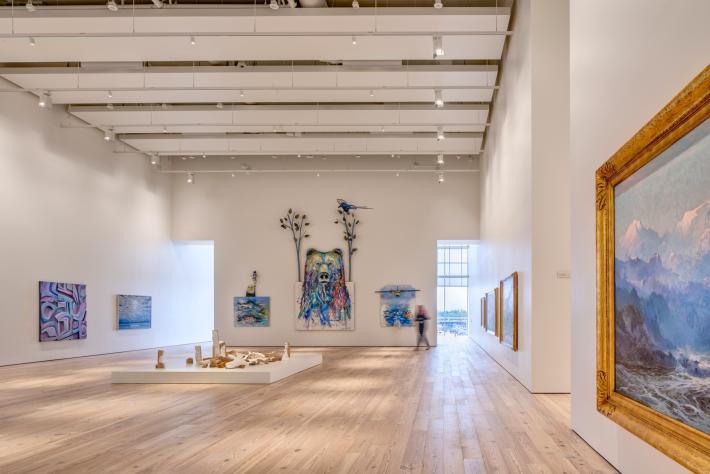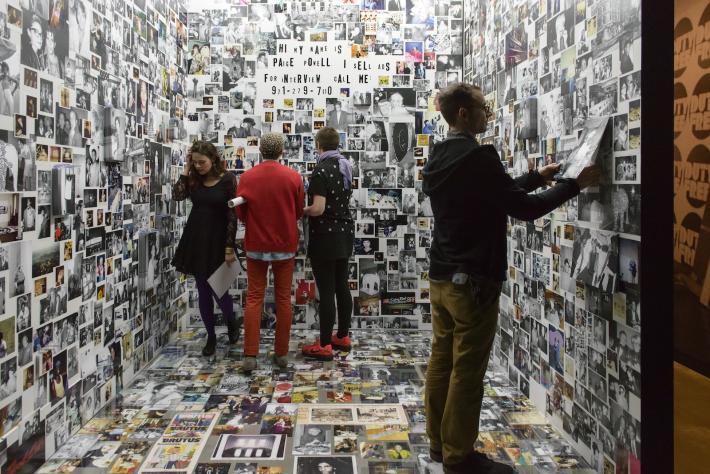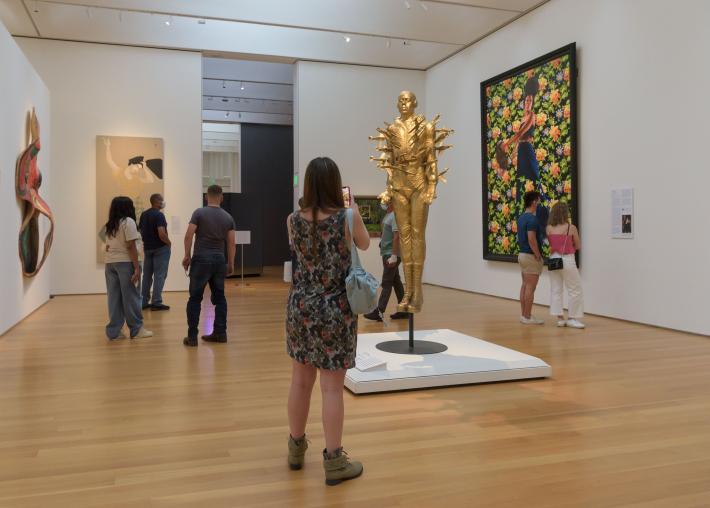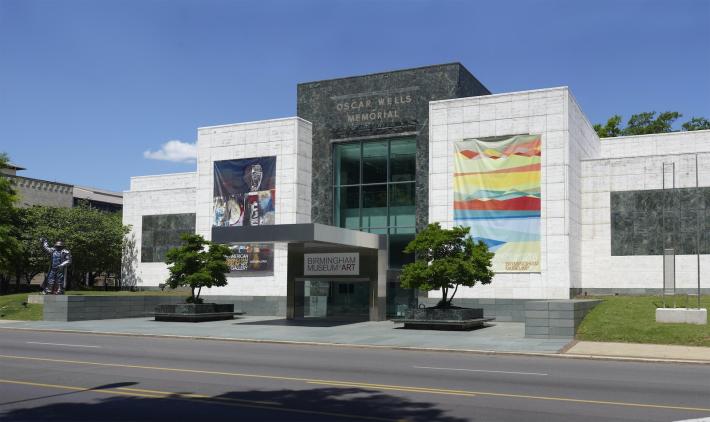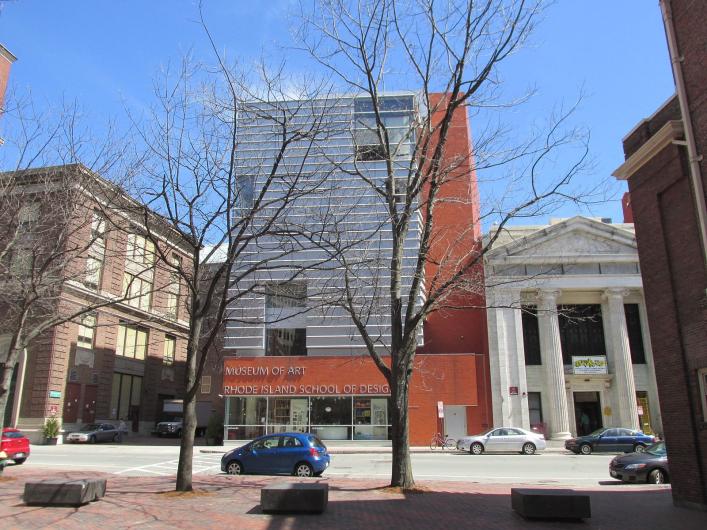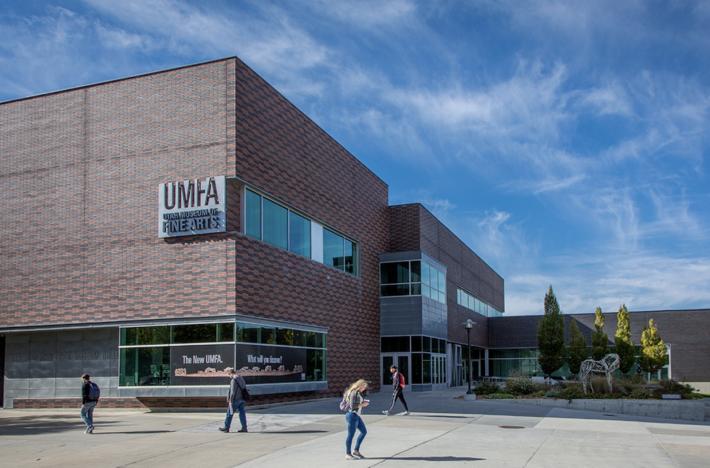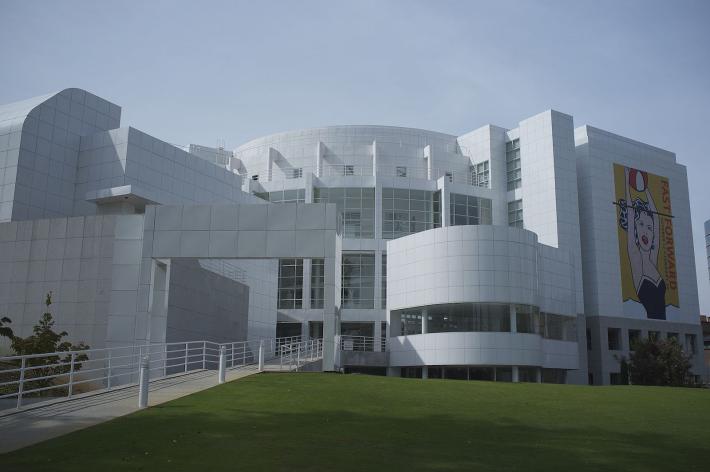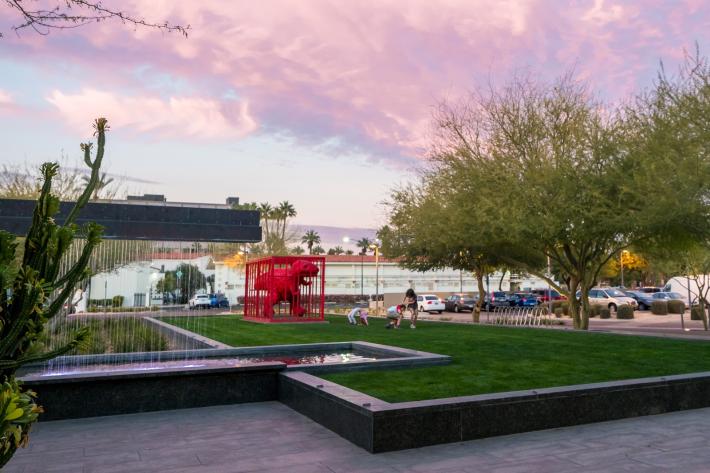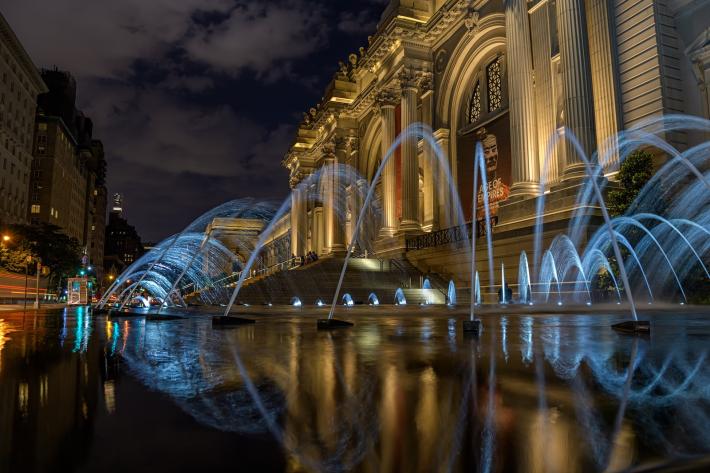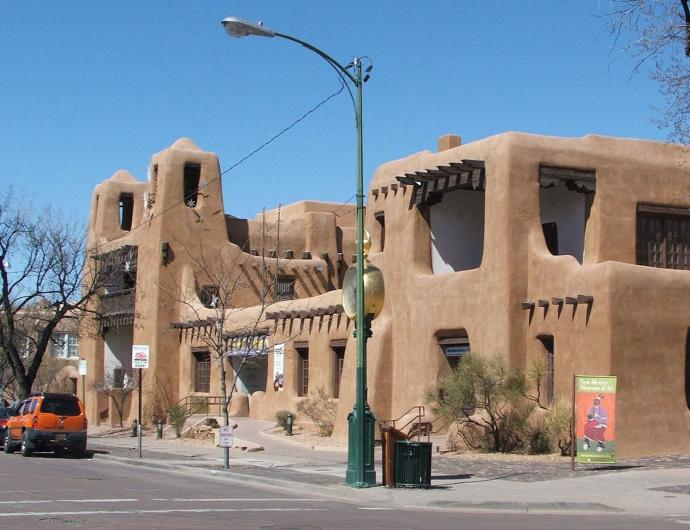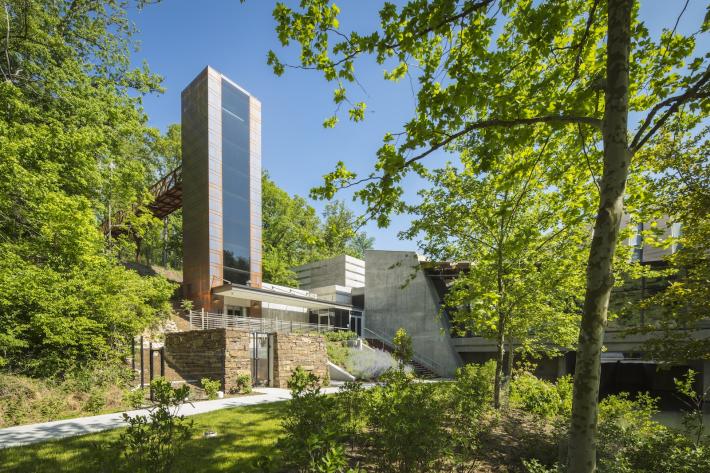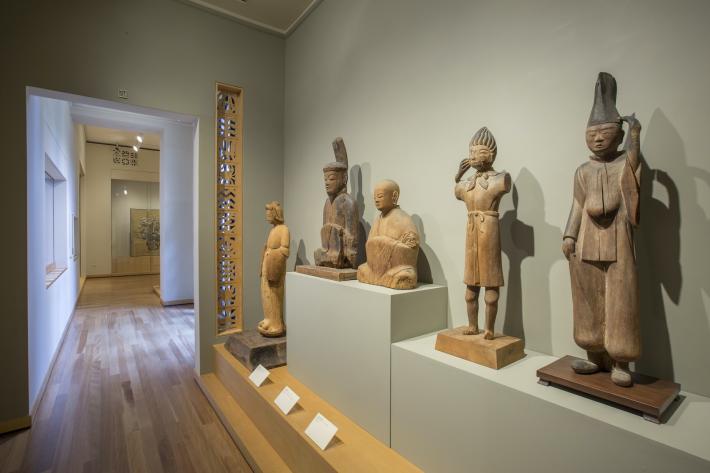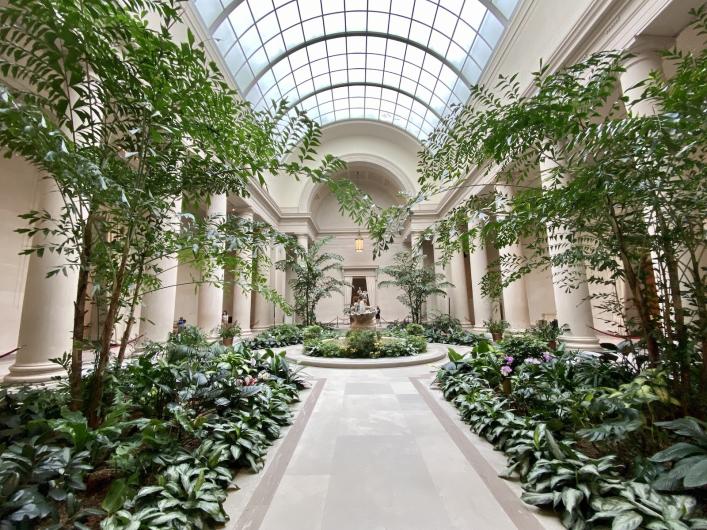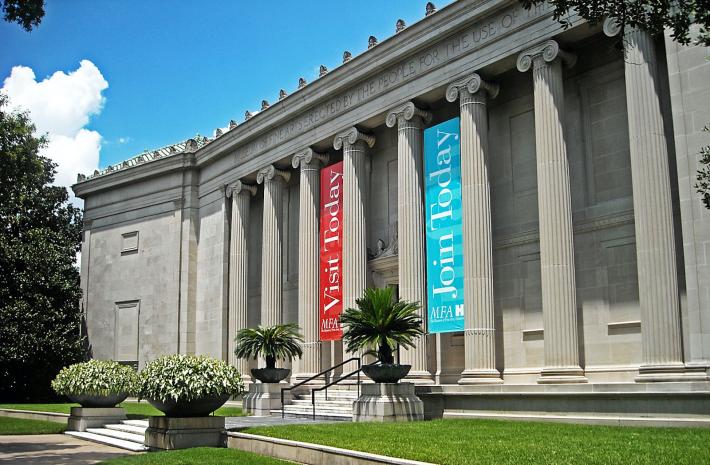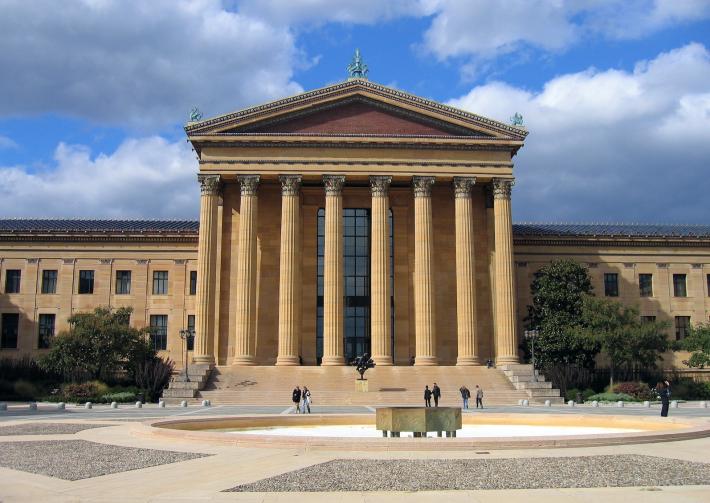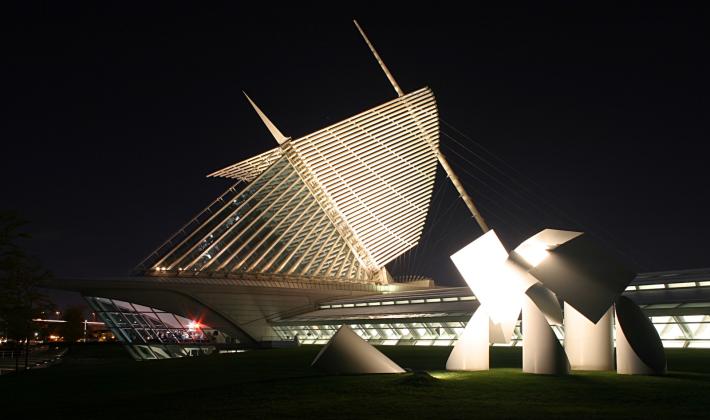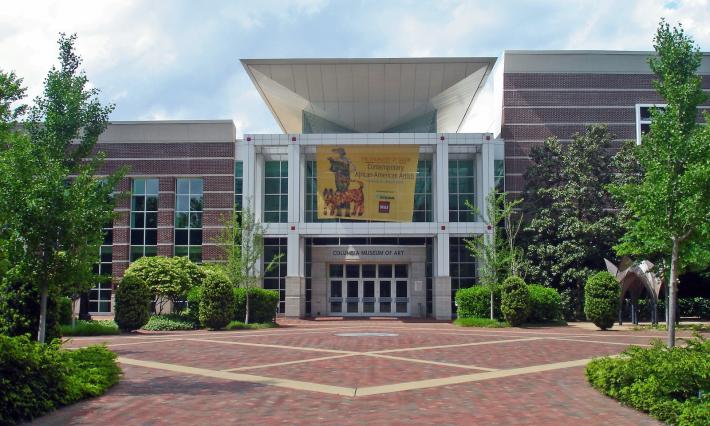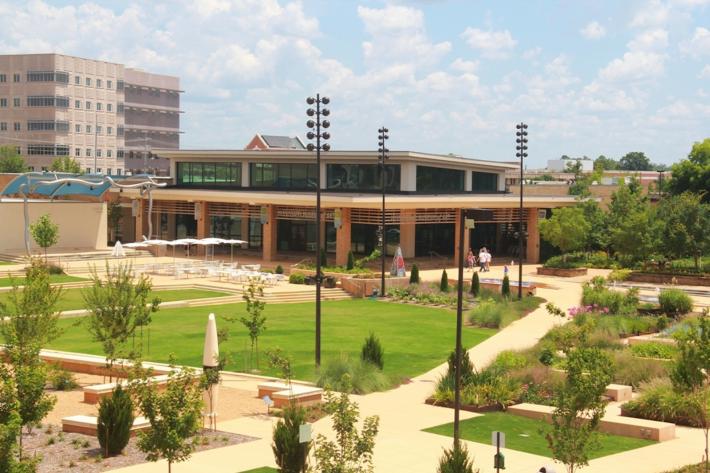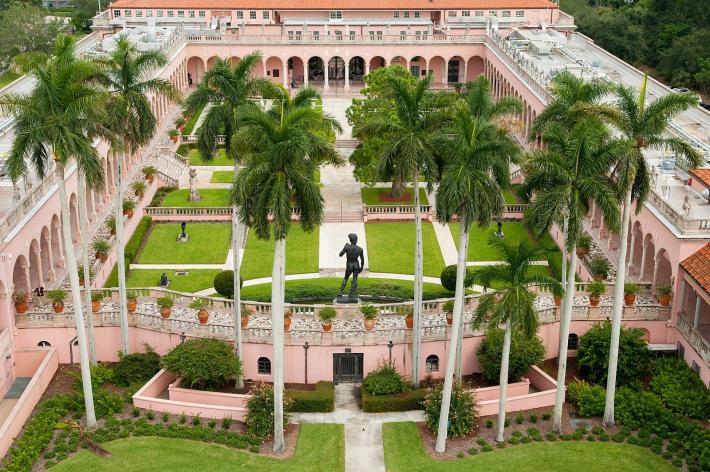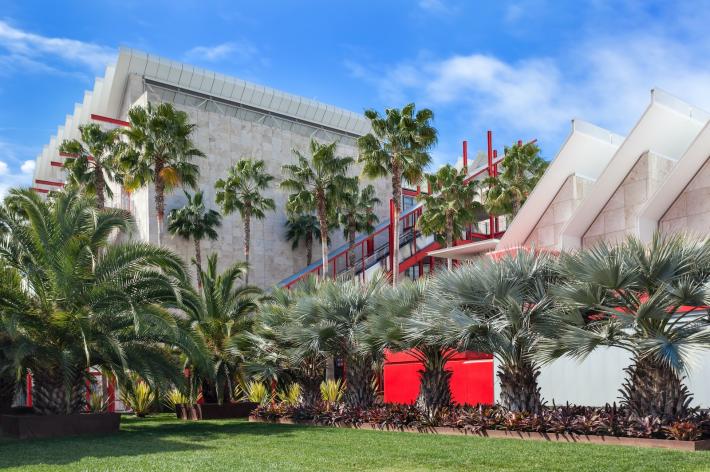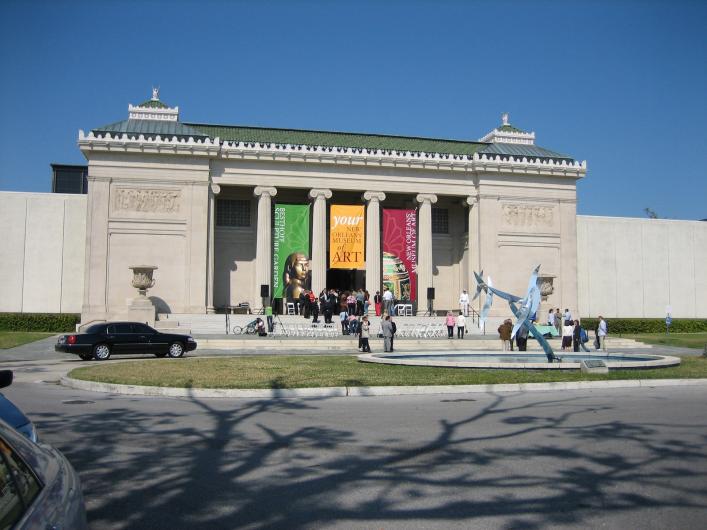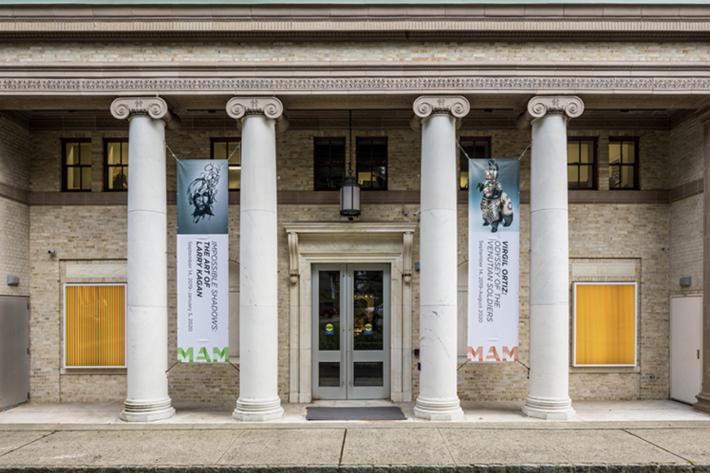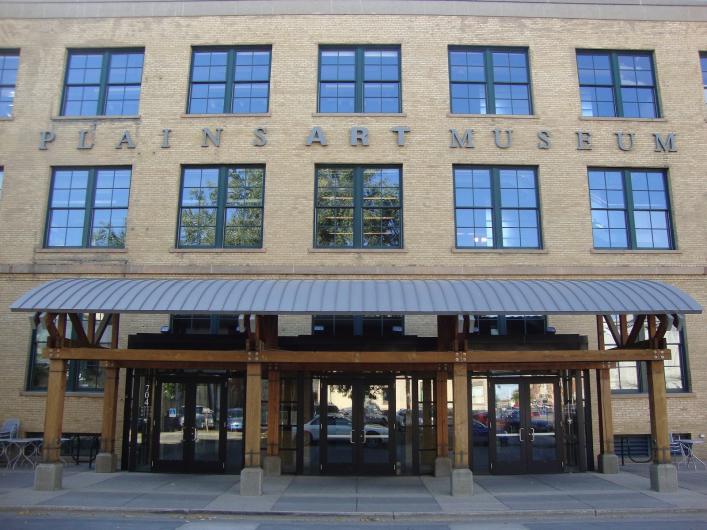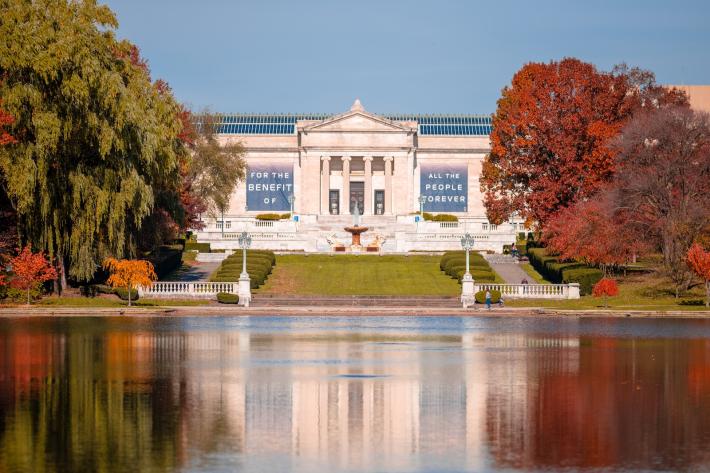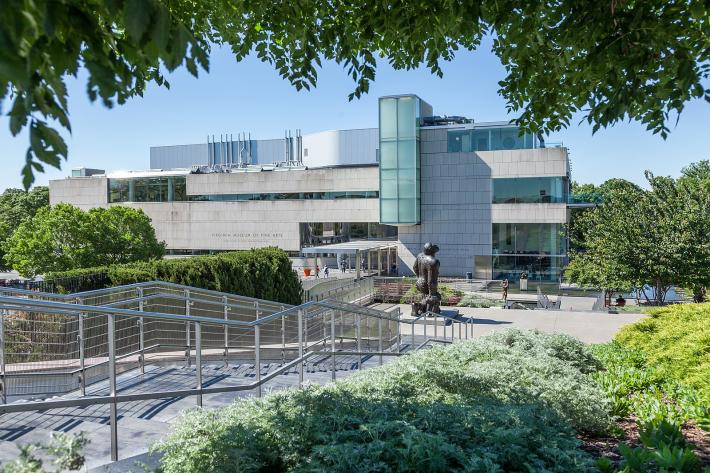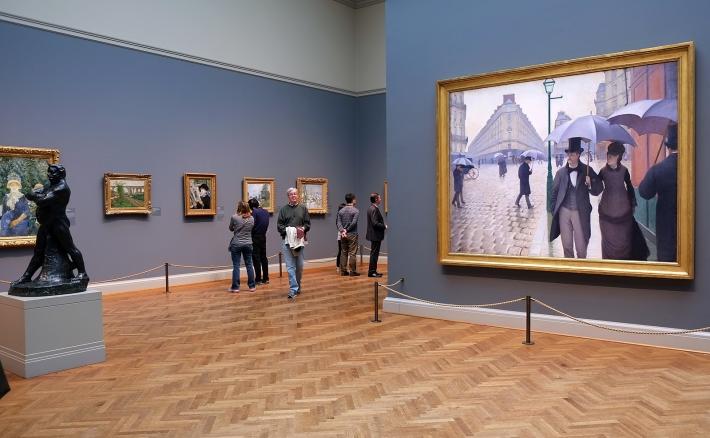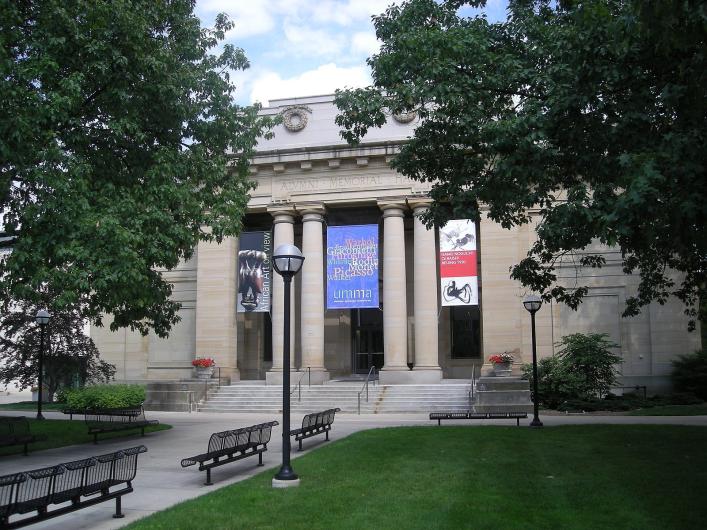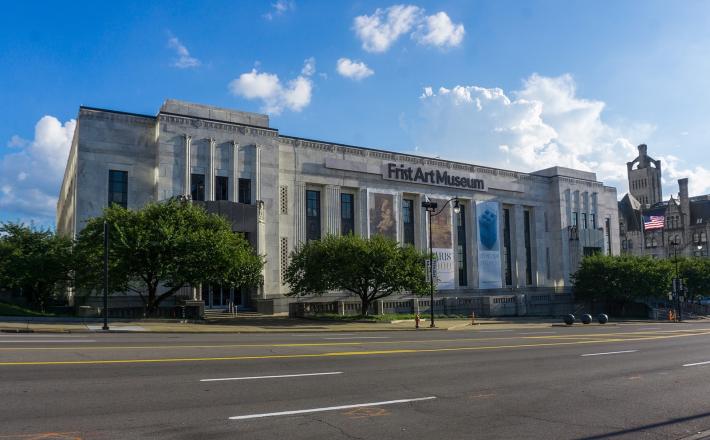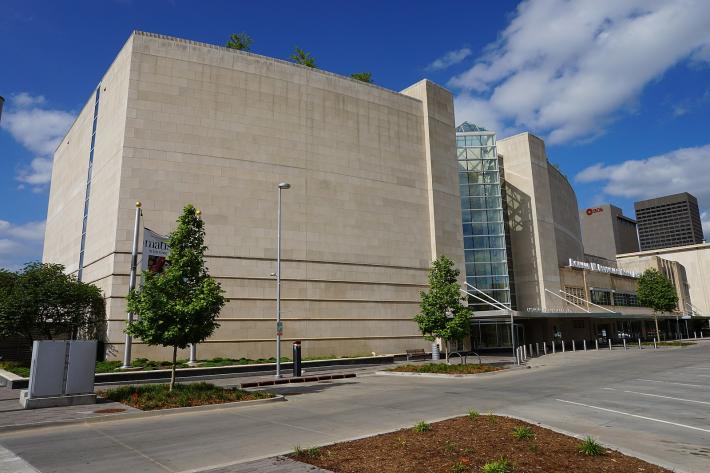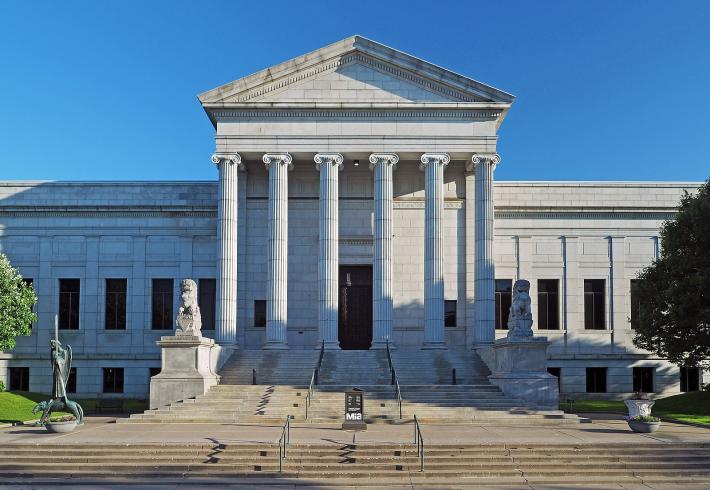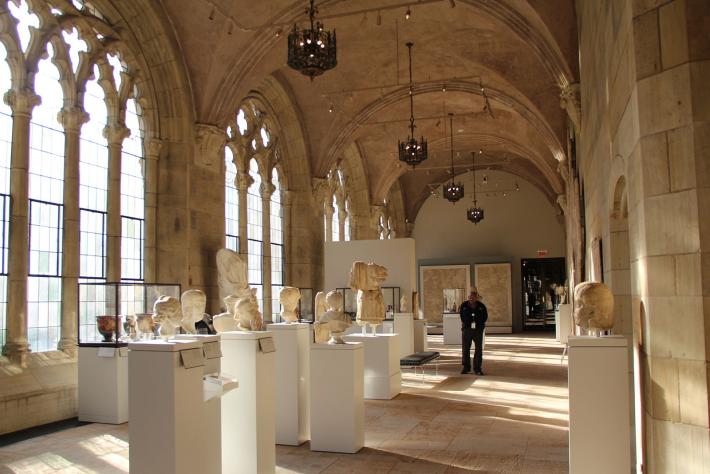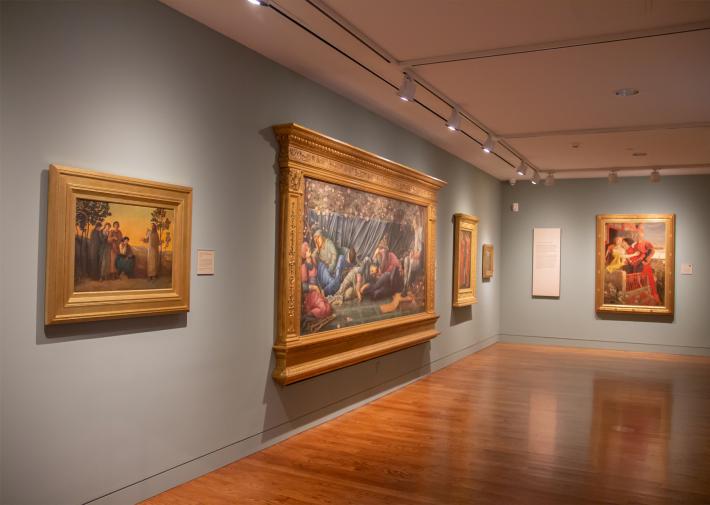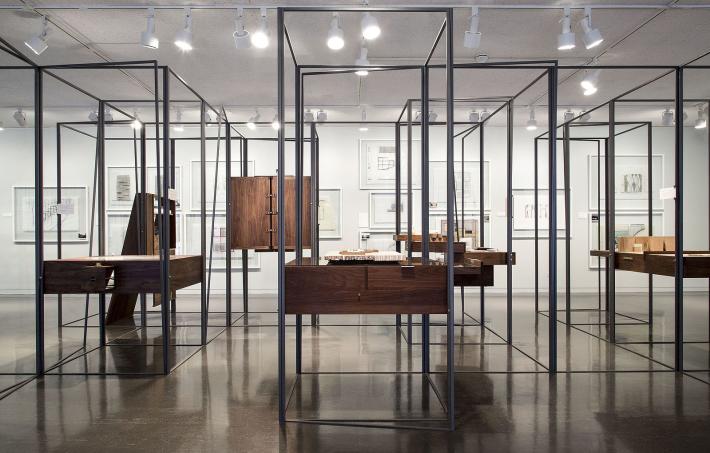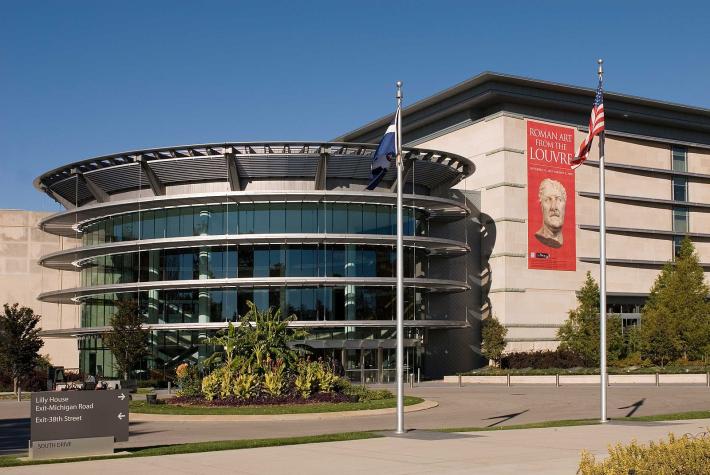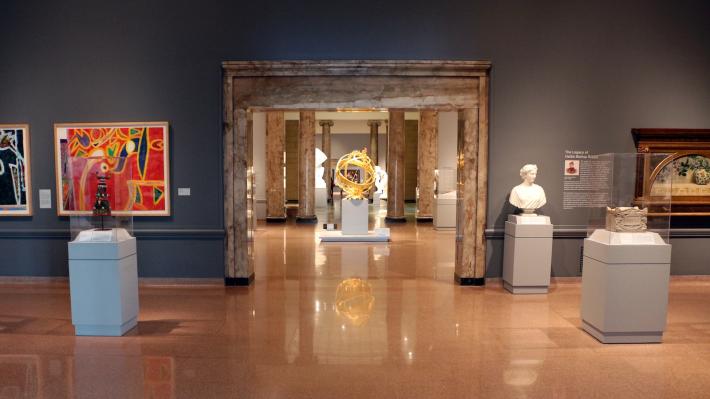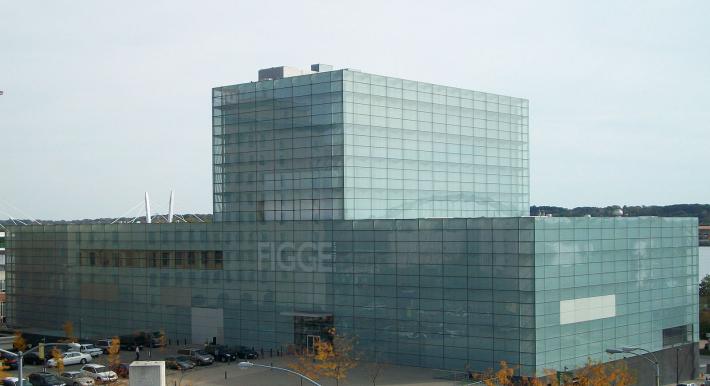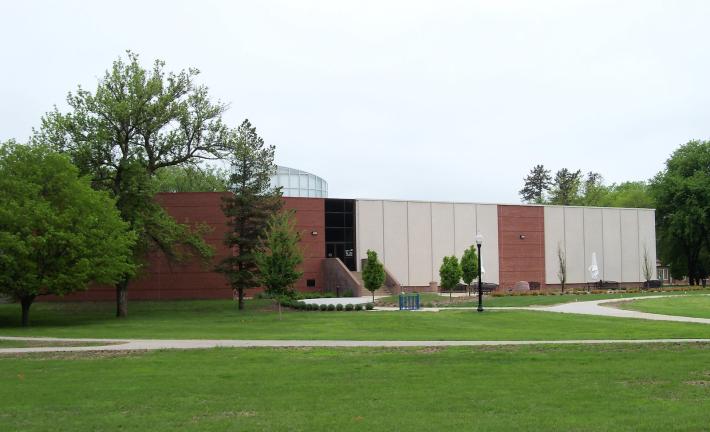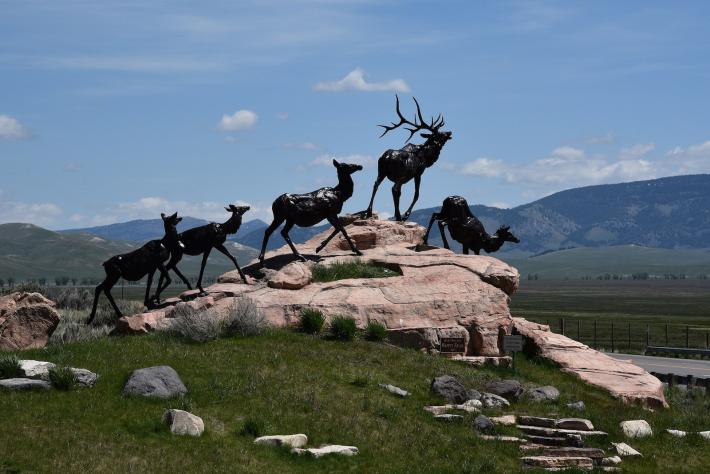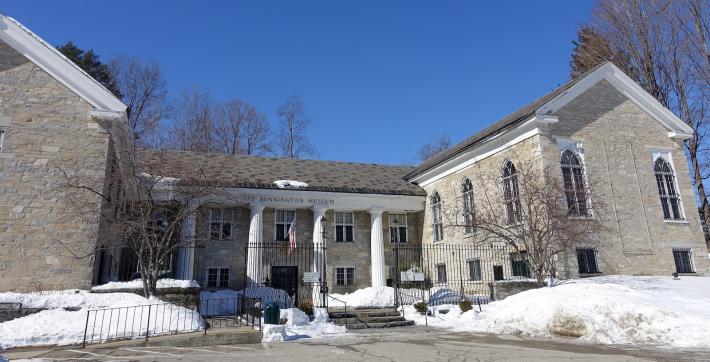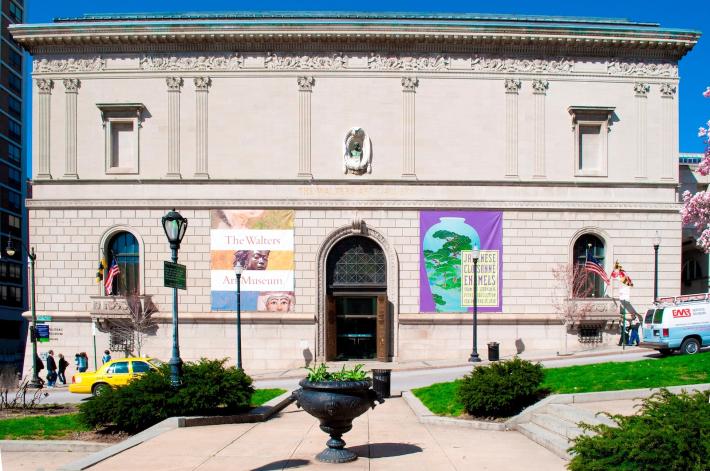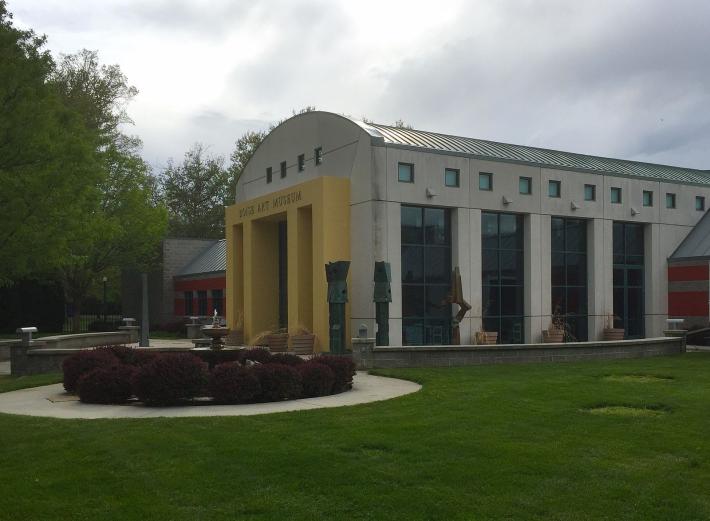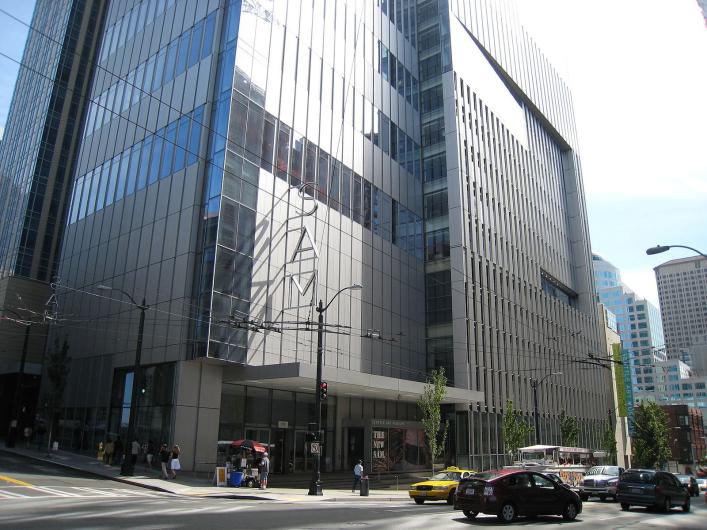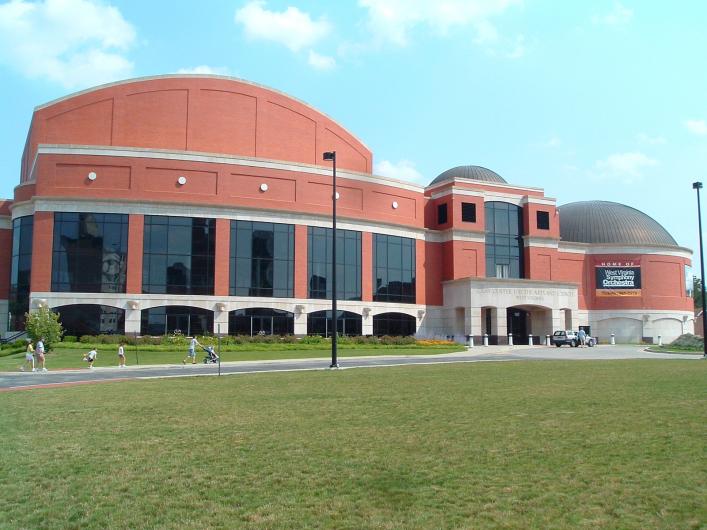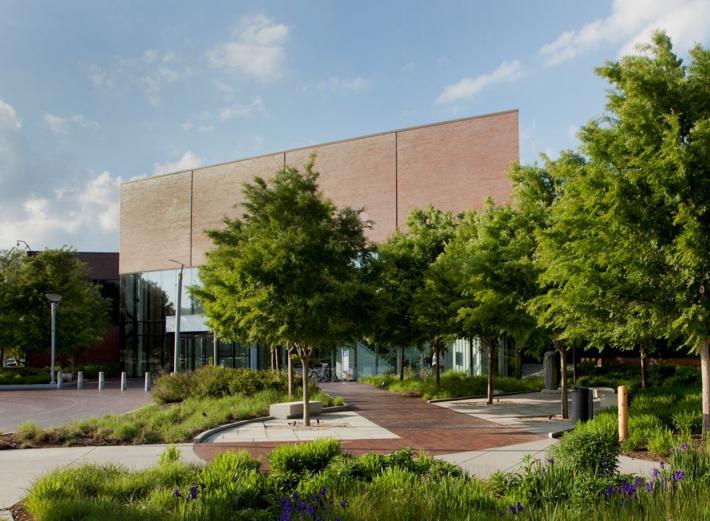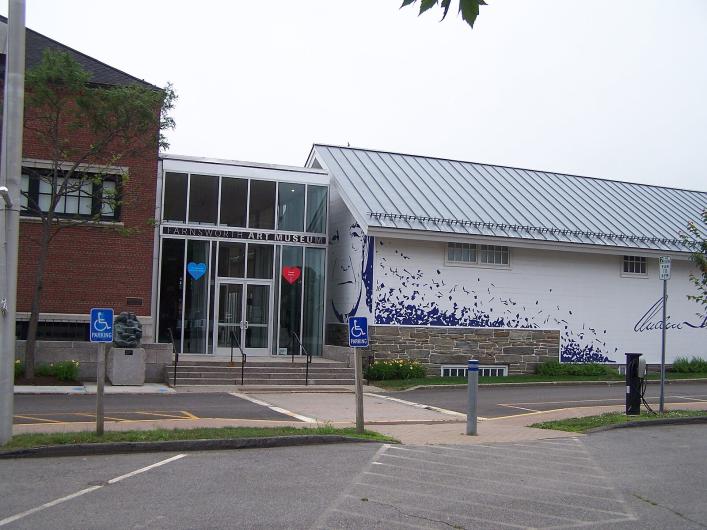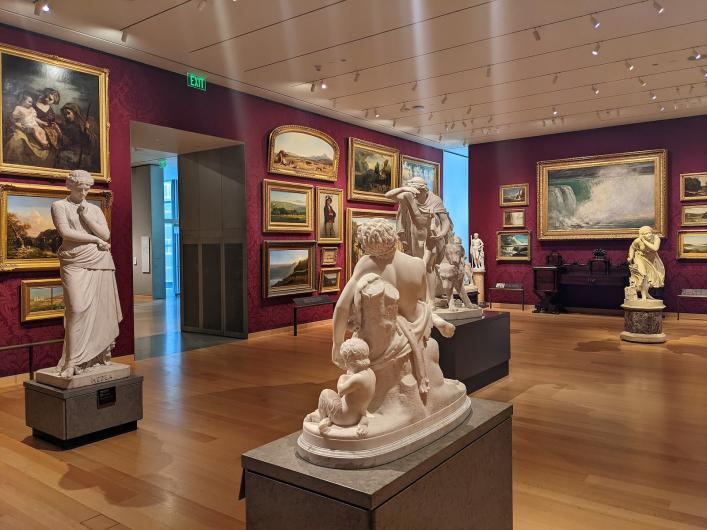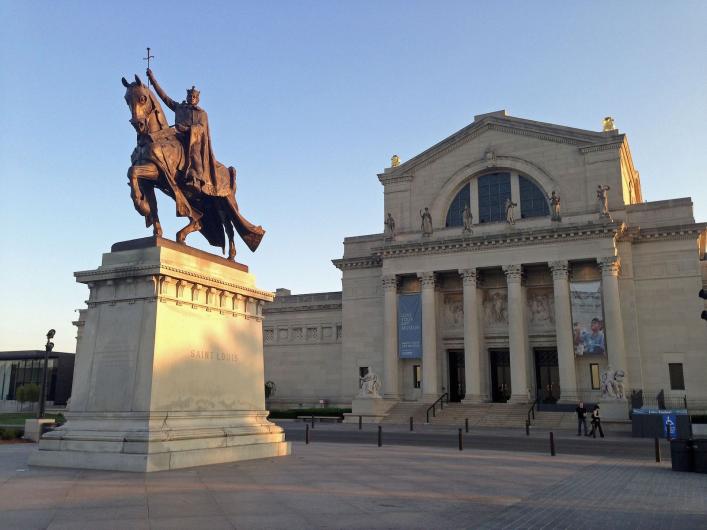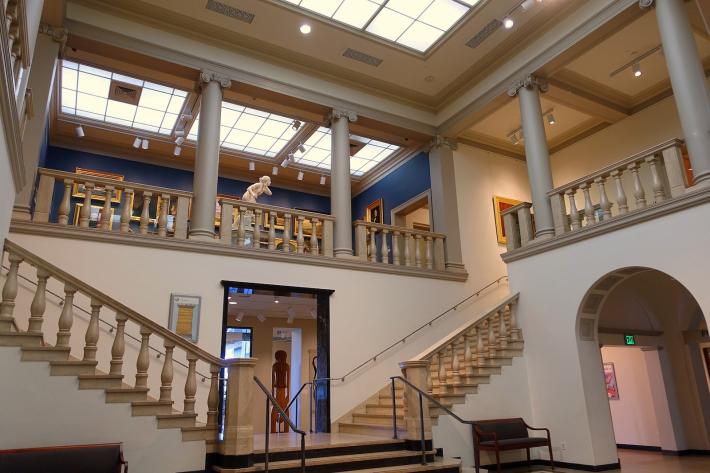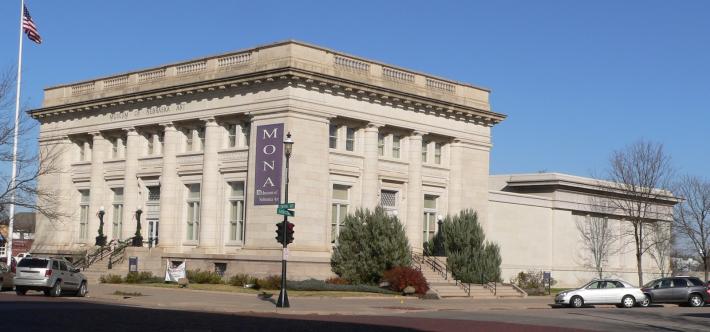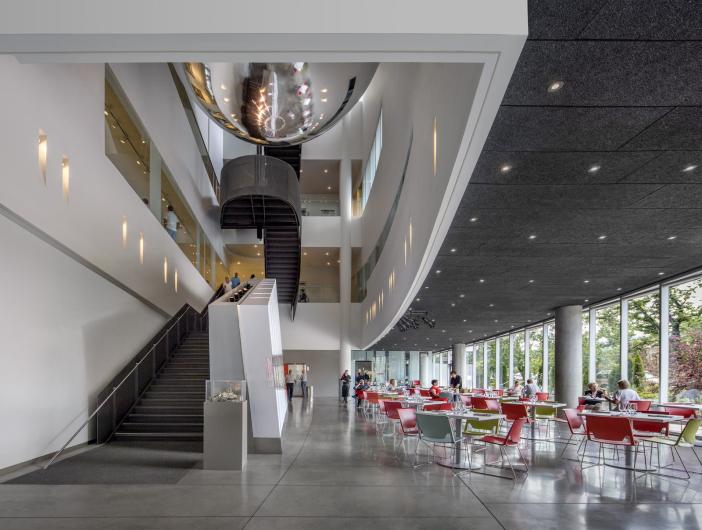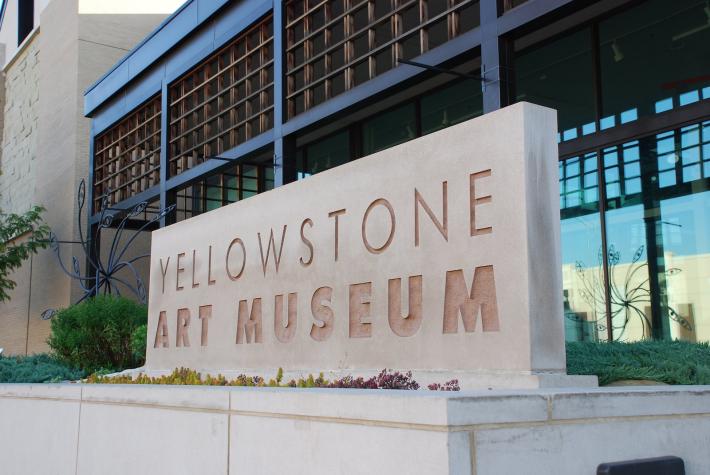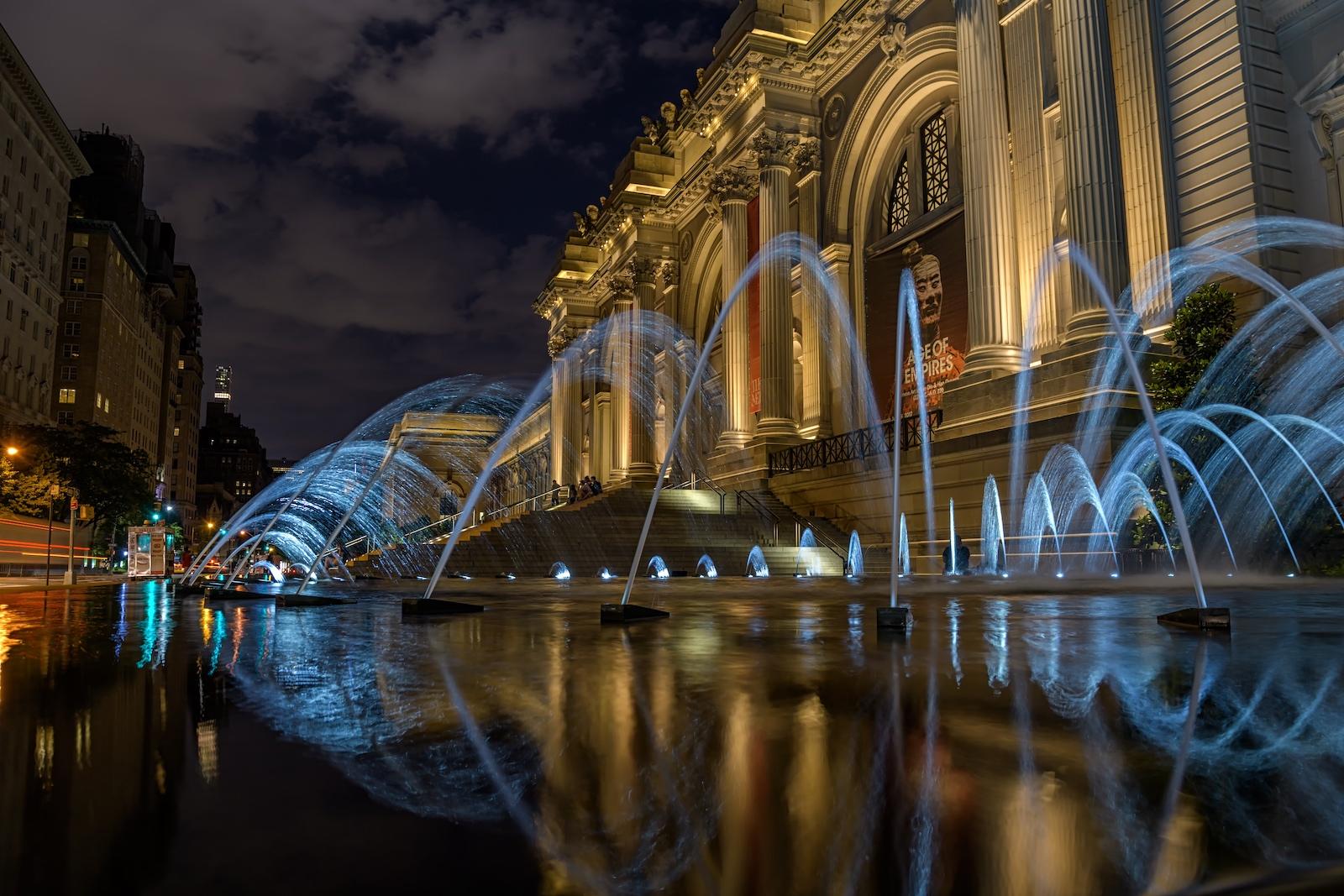
Fountain in David H. Koch Plaza on Fifth Avenue at the entrance of The Metropolitan Museum of Art, Manhattan, New York, NY
Wherever you go in the United States of America, you aren't very far away from art. From intimate galleries to massive world-class collections, art museums worth visiting can be found across the country. In this special roundup, we are highlighting the best art museums in every state, plus the District of Columbia.
With the complex narratives of the North at its core, the Anchorage Museum at Rasmuson Center enthralls with its rich tapestry of social, political, cultural, scientific, artistic, and historical elements. As Alaska's largest museum, it holds a spot in the state's top 10 attractions. It seeks to broaden views, inspire connections, and stimulate international conversations about the North and its distinct ecology. It's positioned on the traditional homeland of the Eklutna Dena’ina, and honors their land, culture, and language. The Museum profoundly respects the enduring links between Alaska Native people, all Indigenous peoples, and their ancestral territories.
Image: Art of the North Gallery 1, 2017 Anchorage Museum Expansion, Kevin G. Smith / Anchorage Museum.
Established in 1892, the Portland Art Museum holds the title of being the oldest in the Pacific Northwest and the seventh oldest in the United States. Its internationally recognized collection exceeds 50,000 objects, from ancient art to contemporary works, displayed across 112,000 square feet of gallery space. With a particular emphasis on Native American art, English silver, and graphic arts, the museum's devotion to art preservation is evident, allocating 90% of its space to the permanent collection. It houses notable sites like the Jubitz Center for Modern and Contemporary Art, the Gilkey Center for Graphic Arts, and the Northwest Film Center. With an impressive 23,000 household membership and an annual visitor count of over 350,000, the museum remains a leading institution in visual arts education.
Image: Visitors engage with exhibit, Portland Art Museum.
Spanning over 5,000 years from ancient to contemporary times, the North Carolina Museum of Art houses a prestigious collection, marking it as a leading art institution in the South. It offers a broad spectrum of educational, aesthetic, and intellectual experiences extending well beyond North Carolina's borders. Covering 164 acres, the Museum Park uniquely blends art and nature, with site-specific environmental art pieces. A dynamic roster of special exhibitions, educational classes, lectures, family-oriented activities, films, and concerts continually enrich the Museum's offerings.
Image: Visitors explore Contemporary art gallery, NCMA.
The Birmingham Museum of Art, considered among America's superior regional museums, boasts an eclectic collection of over 27,000 items. This includes paintings, sculptures, prints, drawings, and decorative arts from diverse eras, ranging from ancient periods to modern times. It offers a cultural kaleidoscope with comprehensive collections of Asian, European, American, African, Pre-Columbian, and Native American art, rendering it a trove of artistic diversity and richness.
Image: Exterior shot of the Birmingham Museum of Art, focusing on the original 1950s era Oscar Wells Memorial Building, Sean Pathasema/Wikimedia Commons.
The RISD Museum, flourishing since 1877, preserves an array of art representing various cultures from different periods. Dedicated to the interpretation of its collection through the lens of the creator, the museum forges a profound connection with art and artists. It presents thought-provoking perspectives and inspires while striving for inclusivity and accessibility to foster relationships across diverse communities. The expansive collection includes over 100,000 art and design pieces, from ancient times to present, with 2,300 on display and 82,196 available digitally. The Museum warmly welcomes the public to freely access digital images of their public domain materials and encourages their widespread usage and distribution.
Image: Museum of Art, RISD, Providence Rhode Island, John Phelan/ Wikimedia Commons.
The Utah Museum of Fine Arts (UMFA), nestled in the University of Utah, presents a diverse vista of global visual arts. Exhibiting artifacts from ancient times to the most recent contemporary works, UMFA offers a unique exploration of human history and artistic ingenuity. Its dynamic collection, comprising close to 20,000 original artworks, stands as the region's most vibrant. As a crucial cultural nucleus for the state and the University, UMFA fosters an engaging dialogue among various campus and community audiences.
Image: Exterior of museum, UMFA.
Nestled in Atlanta's core, the High Museum of Art draws global audiences, known for its distinguished collection, vibrant special exhibitions, and community-centric programs. Showcased in spaces designed by esteemed architects Richard Meier and Renzo Piano, the High houses over 18,000 art pieces. Highlights include a rich compendium of 19th- and 20th-century American fine and decorative arts, extensive photography, folk and self-taught works, especially those from the American South. Its modern and contemporary art collection is ever-growing, and it holds significant European paintings and works on paper, as well as an expanding African art collection spanning prehistory to present. The High commits to mirroring community diversity and creating immersive experiences through varied exhibitions and educational programs.
Image: Exterior view of the High Museum of Art, Wikimedia Commons.
Situated in the Central Corridor of a lively desert city, Phoenix Art Museum has been an arts and culture hub for six decades. As the most extensive art museum in the southwestern United States, it hosts a significant collection exceeding 20,000 objects. Each year, it welcomes over 300,000 visitors, eager learners, and art enthusiasts, offering them immersive experiences both within the Museum and through diverse community programs. The Museum is renowned for presenting world-class exhibitions and creating opportunities for learning and connection, making it a mainstay of cultural engagement in the region.
Image: Entry Plaza at Phoenix Art Museum.
The Metropolitan Museum of Art, boasting a collection encompassing over 5,000 years of global art, resides in two emblematic New York City locations - The Met Fifth Avenue and The Met Cloisters. Its digital platform extends The Met experience to millions worldwide. Established in 1870, The Met transcends being a simple repository of exquisite objects. Daily, its galleries, exhibitions, and events vivify art, uncovering fresh insights and unanticipated links, bridging time and cultures.
Image: Fountains at The Met, G. Scott Segler / Wikimedia Commons.
Boasting over 20,000 American and European artworks, the New Mexico Museum of Art stands as the state's oldest art institution, established in 1917. It occupies a stunning Pueblo Revival edifice, epitomizing the fusion of Native American and Spanish colonial design. The collection largely showcases American art, spotlighting creatives active in the Southwest. Pieces span across diverse mediums, encompassing paintings, prints, sculptures, photographs, and new media. The assembly features works by eminent artists like Georgia O’Keeffe, Edward Weston, and Laura Gilpin, to name a few, ensuring a rich and engaging artistic experience for its visitors.
Image: The New Mexico Museum of Art exterior, Wikimedia Commons.
Crystal Bridges houses a free-to-view permanent collection, traversing five centuries of American art, from early periods to contemporary times. The museum is dedicated to inclusive storytelling, featuring top-tier works from artists traditionally overlooked in art history and standard museum settings. Masterpieces such as Asher B. Durand's Kindred Spirits, Gilbert Stuart's George Washington, and Georgia O’Keeffe's Jimson Weed share space with contemporary talents like Kerry James Marshall and Maya Lin. As the collection expands, temporary exhibitions are mounted to not only complement it, but also to underscore art's ties to equality and justice.
Image: Crystal Bridges North Tower and Lobby, Crystal Bridges.
After receiving a generous gift from The Contemporary Museum in 2011, the Honolulu Academy of Arts underwent a transformation, culminating in 2012 with a name change to the Honolulu Museum of Art (HoMA). Nestled in Honolulu's vibrant heart, HoMA serves as an extraordinary meeting point that intertwines art, history, culture, and education. With a dynamic blend of galleries to explore, films to watch, and art classes to inspire, HoMA aspires to occupy a crucial role within Hawaii's cultural horizon.
Image: Japanese artworks at HoMA.
The National Gallery of Art, a beacon of visual art, education, and culture, was established as a nationwide treasure. Its impressive collection, which encompasses over 150,000 items, encapsulates Western art history and presents remarkable human creativity peaks. It includes paintings, sculptures, decorative arts, photographs, prints, and drawings. With a calendar packed with special exhibitions and public programs, the National Gallery, operating 363 days annually, generously provides all its offerings without charge.
Image: Indoor Garden, National Gallery of Art, TF12/ Wikimedia Commons.
Since its inception in 1900, the Museum of Fine Arts, Houston, ranks among America's top ten art museums. It houses nearly 70,000 art pieces ranging from ancient to contemporary times. The museum comprises structures like the Audrey Jones Beck Building, the Caroline Wiess Law Building, the Lillie and Hugh Roy Cullen Sculpture Garden, and the recently opened Nancy and Rich Kinder Building. Other highlights include the Glassell School of Art, The Brown Foundation, Inc. Plaza, two libraries, a cinema, public archives, and conservation facilities. Moreover, the Bayou Bend Collection and Gardens, and Rienzi house museums display American and European decorative arts. The museum also hosts the International Center for the Arts of the Americas (ICAA), a premier research institute for Latin American and Latino art of the 20th-century.
Image: Exterior of Museum of Fine Arts, Houston, H2H/ Wikimedia Commons.
Bearing a longstanding alliance with the city, region, and global art museums, the Philadelphia Museum of Art diligently protects, enriches, explicates, and widens the scope of its esteemed collections, thus serving as a fountain of joy, enlightenment, and perennial education to a growing, diverse audience. A near-150-year legacy speaks volumes of Philadelphia's unique art aficionados and curators. Its vast repository boasts over 240,000 works, covering a wide array of genres: American art, Contemporary art, costume and textiles, East Asian art, European decorative arts, and European painting.
Image: Exterior Philadelphia Museum of Art, Wikimedia Commons
Proudly housing a collection of 30,000 works, the Milwaukee Art Museum has established itself as an indispensable wellspring of inspiration and learning for over 400,000 visitors annually. With a lineage tracing back to Milwaukee's inaugural art gallery in 1888, the museum has become a city landmark and a statewide treasure. The museum's impressive 341,000-square-foot space encompasses the War Memorial Center by Eero Saarinen, the Kahler Building by David Kahler, and the Santiago Calatrava-designed Quadracci Pavilion. The institution places paramount emphasis on its educational mission, offering a multitude of programs – including classes, tours, and events for all age groups – making it one of the nation's largest educational resources in the arts.
Image: Milwaukee Art Museum at Night, Wikimedia Commons
The Columbia Museum of Art is a dynamic hub, forging robust connections through diverse art, both local and international. With an emphasis on inclusivity, the museum showcases a vast and varied permanent collection that is amongst the southeast's most significant, notably featuring Renaissance and Baroque works. The museum's ingenious thematic organization allows visitors to delve into comparable concepts spanning different epochs. For instance, tracing the evolution of a theme such as 'Vice and Virtue' over the years fosters a more enriching and insightful journey. The museum's ever-changing exhibitions further enhance the artistic adventure, maintaining a vibrant and engaging atmosphere.
Image: The Columbia Museum of Art , Wikimedia Commons
The Mississippi Museum of Art transcends being simply an art museum in Jackson, Mississippi, evolving into a comprehensive reflection of the state itself. This museum serves as a vital link, bridging Mississippi's culture, history, and communities, and fostering a sense of unity among its people. Guided by the rich heritage of its past and driven towards a future devoid of division, the museum transforms into a nexus for community interaction, tranquil contemplation, and burgeoning friendships. It cultivates an environment of knowledge expansion, authentic human connection, and artistic stimulation, making it a distinct beacon of inspiration in Mississippi.
Image: The Mississippi Museum of Art, Wikimedia Commons
The Ringling in Sarasota, Florida stands as a distinguished hub for art, history, and knowledge, dedicated to the marriage of historical and contemporary culture through exceptional visitor experiences. The campus, enriched with the Museum of Art, the Circus Museum, a historical mansion, an 18th-century theater, and bayfront gardens, holds a prestigious position in the National Register of Historic Places. As Florida's State Art Museum and a component of Florida State University, The Ringling plays a critical role in education. It offers both formal and informal study programs, positioning itself as a crucial resource for learners of all ages, scholars, and students, extending its reach from the local region to national and global scales.
Image: The Ringling Museum of Art, Wikimedia Commons
LACMA, situated on the Pacific Rim, stands as the largest art museum in the western United States. Its vast collection exceeds 147,000 objects, shining a light on 6,000 years of global artistic expression. Dedicated to representing a breadth of artistic histories, LACMA delivers fresh, regionally-informed perspectives in its exhibitions and interpretations. Echoing its commitment to innovation, LACMA collaborates with artists, technologists, and thought leaders. Moreover, it cultivates regional, national, and global partnerships to broaden access to collections and programs, spearhead trailblazing initiatives, and reach out to new audiences.
Image: Exterior of BCAM (Broad Contemporary Art Museum) at the Los Angeles County Museum of Art, photo © Museum associates/ LACMA
Established in 1911, New Orleans Museum of Art (NOMA), the city's eldest fine arts institution, launched with a mere nine art pieces. Fast forward to now, and NOMA proudly presents a robust permanent collection exceeding 40,000 objects. With standout pieces in French and American art, photography, glass, and African and Japanese works, NOMA is among the South's premier art museums. The twelve-acre Sydney and Walda Besthoff Sculpture Garden adds to NOMA's allure, housing over 90 sculptures within an exquisitely landscaped area. Its meandering footpaths, reflective lagoons, and flora, including 200-year-old live oaks, pines, and magnolias, render it one of the U.S.'s paramount sculpture installations.
Image: New Orleans Museum of Art, Wikimedia Commons.
The Montclair Art Museum (MAM) features a distinguished collection of American and Native American art, encapsulating the progression of U.S. artistry over three centuries. Its Native American artwork collection dates back to around 1200 C.E., reaching into the present day. The Museum's educational outreach is located within the Vance Wall Art Education Center, hosting the renowned Yard School of Art studio classes, along with lectures, tours, and the mobile MAM Art Truck. Catering to a diverse audience, MAM's exhibitions and programs invite participation from all age groups - families, senior citizens, artists, educators, and scholars alike.
Image: The Montclair Art Museum, MAM.
Established in 1965 as the Red River Art Center in Moorhead, Minnesota's former post office, the institution became Plains Art Museum in 1975. In 1997, the Museum moved to a renovated early-20th-century warehouse in downtown Fargo, North Dakota, redesigned by renowned firm Hammel Green & Abrahamson, Inc. The museum, spanning 56,000 square feet with 9,000 designed for secure, climate-controlled exhibits, features amenities like the Hannaher’s, Inc. Print Studio, The Dawson Studio, The Store, and the Goldberg Art Lounge. It showcases approximately 12 major and several smaller exhibitions annually, focusing on 20th and 21st-century art. The Museum also complements its exhibition schedule with classes, lectures, interdisciplinary collaborations, social events, and performances.
Image: Plains Art Museum, AJ LEON, Wikimedia Commons.
The Cleveland Museum of Art, located in the University Circle neighborhood, stands out for the remarkable depth and variety of its collection, featuring over 63,000 artworks tracing back 6,000 years in the annals of art. Esteemed as an essential global stage for exhibitions, scholarly study, and the performing arts, the museum is a trailblazer in digital breakthroughs. Its status among the nation's premier art institutions is bolstered by its praiseworthy Open Access program and the fact that it provides cost-free admission to all visitors.
Image: The Cleveland Museum of Art, Wikimedia Commons.
Located in Richmond, Virginia, the Virginia Museum of Fine Arts stands among America's largest, all-inclusive art museums. Since its inception in 1936, VMFA operates as both a state agency and a privately endowed educational institution, fostering the arts by safeguarding, displaying, and deciphering them. With the Office of Statewide Partnerships program, it hosts exhibitions, multimedia arts programs, symposiums, lectures, conferences, and workshops. Visitors can traverse a global art collection spanning over 6,000 years, with almost 50,000 pieces. Key holdings range from the most extensive public collection of Fabergé outside Russia to the leading Art Nouveau collection outside Paris, and top-rated American, Chinese, and French Impressionist art. Its 2010 expansion was a milestone in the museum's history.
Image: The Virginia Museum of Fine Arts, Wikimedia Commons.
The Art Institute of Chicago, established in 1879, holds a notable status among global museums. Its vast collection boasts a myriad of objects that traverse geographies, cultures, and eras. Dedicated to the pursuit of knowledge and innovation, this institution serves as a hub for education and meaningful conversation. Its continuous endeavors to amplify public service and foster civic engagement solidify its esteemed reputation.
Image: Art Institute of Chicago gallery, Wikimedia Commons.
The University of Michigan Museum of Art stands as a catalyst for personal and societal transformation, endorsing the exploration and appreciation of global art. Following its expansion in 2009, marked by the addition of the expansive Frankel Family Wing and the rejuvenation of the historic Alumni Memorial Hall, the Museum transitioned into a vibrant cultural hub for the 21st century. With expansive new galleries showcasing a selection from their vast collection of over 20,000 pieces, dynamic exhibition spaces, accessible storage galleries, and a variety of educational and event arenas, the Museum strives to engage its visitors and foster a sense of belonging.
Image: The University of Michigan Museum of Art, Wikimedia Commons.
Since its inception in April 2001, the Frist Art Museum has been a focal point of high-caliber, rotating exhibitions, showcasing a blend of acclaimed global collections and in-house organized, award-winning exhibits. The exhibition lineup evolves frequently, ensuring novel experiences for frequent visitors. Moreover, the museum takes pride in the Martin ArtQuest Gallery - a recipient of numerous accolades for its unique and family-friendly environment. This dynamic, interactive space encourages visitors across all ages and skill levels to delve deeper into exhibit concepts via experiential learning. While adult guests gain free access to MAQ with gallery admission, those aged 18 and younger enjoy complimentary entrance.
Image: The Frist Art Museum, Wikimedia Commons.
The Oklahoma City Museum of Art holds a prominent position among regional arts establishments, hosting a vibrant array of exhibitions sourced from renowned global museums and collections. Its eclectic collection houses significant works from North America, Europe, and Asia, emphasizing American art and postwar abstraction. Notable collections include a substantial public exhibit of Dale Chihuly glass, Brett Weston's photography, and an unparalleled assortment of works by Washington Color artist Paul Reed. The revered Samuel Roberts Noble Theater offers a selection of international, independent, documentary, and classic films. The Museum also features a store and a roof terrace. Accredited by the American Alliance of Museums and a member of the Association of Art Museum Directors, it welcomes over 125,000 annual visitors from every U.S. state and thirty foreign countries.
Image: The Oklahoma City Museum of Art, Michael Barera, Wikimedia Commons
Encompassing 90,000 works of art spanning 5,000 years, the Minneapolis Institute of Art (Mia), located in Minneapolis, Minnesota, stands as one of the country's expansive art museums. Its eminent permanent collection presents high-level artistic masterpieces from six continents over 20,000 years, showcasing global cultural diversity. The museum boasts seven specialized curatorial areas including the Arts of Africa & the Americas, Contemporary Art, Decorative Arts, Textiles & Sculpture, Asian Art, Paintings, Photography and New Media, and Prints and Drawings. Mia has a strong educational focus, ranking as a top art educator in Minnesota. It serves more than half a million visitors annually, extending its reach to an additional hundred thousand through its Art Adventure program for young students. Its free admission, public programs, interactive media programs, and classes ensure deep engagement within local communities.
Image: Minneapolis Institute of Art, McGhiever, Wikimedia Commons
The Yale University Art Gallery, established in 1832 as the first art museum at an American university, boasts a remarkable collection of nearly 300,000 artworks across diverse media, cultures, and time periods. This extraordinary collection shapes the gallery's identity and fuels its endeavors. As a critical cultural asset for Yale University and beyond, the gallery serves as a vibrant hub for education, research, and scholarship. The gallery's commitment to inclusivity is reflected in its free admission policy and thoughtful engagement with audiences through innovative exhibitions, comprehensive programs, and scholarly publications.
Image: The Yale University Art Gallery Greek and Roman Sculpture Hall, Nick Allen, Wikimedia Commons
Established in 1912 as a tribute to esteemed illustrator Howard Pyle, the Delaware-based museum has evolved into a leading arts and cultural beacon over a century. Housing over 12,000 artworks within its premises and sculpture garden, the institution stimulates exploration, connection, and discovery through art. Its treasures include the largest collection of British Pre-Raphaelite art outside the UK, affirming its global relevance. Concurrently, the museum is expanding its contemporary art collection, asserting its dynamic and forward-thinking spirit.
Image: The Delaware Art Museum Pre-Raphaelite Gallery, The Delaware Art Museum
As one of the largest art museums from Chicago to the West Coast, the Denver Art Museum, established in 1893 as the Denver Artists' Club, boasts over 70,000 artworks. The 12 diverse collections span African art, architecture, design, ancient Americas, Asian art, pre-1900 European and American art, Latin American and Oceanic art, contemporary, photography, textiles, fashion, Indigenous North American arts, and western American art. Significantly, the museum showcases works by Denver and Rocky Mountain artists, offering the community enriching insights into the global art scene.
Image: View of Case Work: Studies in Form, Space and Construction at the Denver Art Museum, Altamontstreet, Wikimedia Commons
Newfields, a 152-acre cultural hub, combines art and nature with its art galleries, gardens, a historical mansion, a nature preserve, and a sculpture park. It houses the Indianapolis Museum of Art Galleries, one of the oldest and largest general art museums in the country, and The Toby, a venue for concerts. There's also The Garden, a 40-acre space featuring contemporary and historic greenery, a greenhouse, and an orchard. The Virginia B. Fairbanks Art & Nature Park stands as one of the country's largest art and nature parks. The campus extends beyond Indianapolis to Columbus, IN, with the highly respected mid-century Modernist architecture of Miller House and Garden.
Image: Newfields, Wikimedia Commons
The Speed Art Museum, Kentucky’s preeminent art institution, rests on the University of Louisville campus. Founded in 1927 by local philanthropist Hattie Bishop Speed, who fervently believed in art's transformative capacity, it has maintained its mission to inspire a lifelong celebration of art. As an independent and comprehensive museum, it features a diverse range of artistic treasures.
Image: Gallery in Speed Museum, Wikicommons
Between Chicago and Des Moines, the Figge Art Museum serves as the preeminent center for art exhibitions and educational endeavors. Its stunning glass structure, a creation of British architect David Chipperfield and situated along the Mississippi, houses a top-tier Midwest art collection. It hosts high-quality traveling exhibitions while offering vibrant art classes, insightful lectures, and exclusive events in its dynamic studios, auditorium, and generous lobby, appealing to diverse age groups.
Image: Figge Art Museum, Wikicommons
The South Dakota Art Museum, a cultural hub since 1970, showcases the artistic heritage of South Dakota in a globally relevant context. Its seven galleries host 15-17 fresh exhibitions annually, exhibiting a myriad of artworks and themes that weave South Dakota's narrative with global insights. With a diverse collection exceeding 7,000 pieces - from paintings and photos to sculptures, textiles, and ceramics - the museum offers a robust artistic experience. Furthermore, the Museum Store provides an assortment of jewelry, pottery, and original local art, complemented by books on South Dakota's historical tapestry and cultural fabric.
Image: South Dakota Art Museum, Wikicommons
Since its inception in 1987, the National Museum of Wildlife Art has housed over 5,000 artworks, making it a pivotal institution in Jackson Hole. Notable artists such as Georgia O’Keeffe, Andy Warhol, and Robert Kuhn, among others, have contributed to its vast permanent collection, spanning the history of wildlife art from 2500 B.C. to today. Congress recognized it as the "National Museum of Wildlife Art of the United States" in 2008. The museum, nestled into a hillside overlooking the National Elk Refuge, hosts a shop, a children's interactive gallery, a restaurant, and an outdoor sculpture trail. Its location, just a stone's throw away from Jackson Town Square and the entrance of Grand Teton National Park, further enhances its appeal.
Image: Wapiti Trail, Bart Walter, National Museum of Wildlife Art, Wyoming, Wikicommons
Unveiling the vibrant culture of southern Vermont, eastern New York State, northwestern Massachusetts, and southern New Hampshire, Bennington Museum offers a deep dive into the region's history from the 18th century onward. Through its vast collection of art and historical artifacts, the museum showcases the area's journey across time and place. With innovative exhibitions and engaging programming, available both online and in-person, the museum offers a comprehensive understanding of this rich cultural region throughout the year.
Image: Bennington Museum, Wikicommons
Showcasing art spanning seven millennia and various cultures, The Walters Art Museum in Baltimore’s Mount Vernon neighborhood stands as one of America’s unique institutions. Free to all, it houses a rich collection of 36,000 art pieces, spread across five historic buildings. The museum's galleries offer an extraordinary journey through art, with displays varying from French 19th-century countryside and urban paintings to Ethiopian icons, illuminated Qur’ans and Gospel books, ancient Roman sarcophagi, and depictions of Buddha. Globally, it connects with audiences through its collections, exhibitions, and educational programs, making it an artistic hub in Baltimore, Maryland.
Image: The Walters Art Museum, Wikicommons
As a central hub of visual arts in Boise, the Boise Art Museum (BAM) stimulates engagement and encourages learning via outstanding exhibitions, robust collections, and comprehensive educational initiatives. BAM takes pride in its rich past as it amplifies its visitors' experiences through top-notch exhibits, strategic interpretation of collections, educational programs, and a congenial environment. With its steadfast dedication to enhancing the community's educational, economic, and cultural life, BAM's impact resonates far beyond its walls.
Image: Boise Art Museum Sculpture Garden, Wikicommons
Since 1933, the Seattle Art Museum (SAM) has emerged as a distinguished hub for visual arts in the Pacific Northwest, as integral to the Seattle cityscape as its coffee, rain, mountains, and iconic landmarks. SAM's tripartite structure symbolizes the city's unique intersection of diverse contrasts - east with west, urbanity with nature, and local with global. Exhibiting art that spans the globe, SAM's collections, installations, and special exhibitions foster intercultural and intergenerational connections. SAM recognizes its establishment on the ancestral land of the Coast Salish people.
Image: Seattle Art Museum, Wikicommons
A beacon of arts and sciences in Charleston, West Virginia, the Clay Center stands as a unique establishment that unites performing arts, visual arts, and scientific explorations under one roof. This 240,000 square-foot structure, inaugurated on July 12, 2003, is among a rare breed of such facilities in the country. It accommodates the Avampato Discovery Museum, the Juliet Art Museum, and the Maier Foundation Performance Hall, which is the proud venue for the West Virginia Symphony Orchestra.
Image: Clay Center, Wikicommons
Originating in 1935, the Wichita Art Museum, an eminent cultural hub in South Central Kansas and the Midwest, owes its inception to the legacy of Louise Caldwell Murdock. Her 1915 will decreed the proceeds from her estate, post the demise of her closest kin, be utilized for procuring art for Wichita city in honor of her late husband, Roland P. Murdock, a kin of Wichita Eagle founder Marshall M. Murdock and business overseer of the family newspaper. The period from 1939 to 1962 saw Elizabeth Stubblefield Navas, a confidante and business colleague of Mrs. Murdock, choose American art pieces for the museum. The collection, now housing 10,000 pieces and bearing a focus on American art, is celebrated nationwide
Image: Wichita Art Museum, Wikicommons
Unveiling 15,000-plus works within its 20,000 square feet gallery, the Farnsworth art museum is a trove of creativity. Renowned for its extensive collection of Louise Nevelson's sculptures, it also houses the Wyeth Center featuring the works of Andrew, N.C., and Jamie Wyeth. Further, it incorporates the Farnsworth library, and two historical structures, the Farnsworth Homestead and the Olson House, along with Julia’s Gallery for Young Artists. Open all year, it stands as a unique hub dedicated to American and Maine-inspired art, and through its exceptional collection, inventive exhibits, and vibrant educational initiatives, it imbues visitors worldwide with a deep understanding of Maine’s significant contribution to American art.
Image: Farnsworth Art Museum, Wikicommons
Dating back to 1870, the Museum of Fine Arts, Boston resides on the ancestral grounds of the Massachusett people, a historic meeting point for different nations. Opening its doors in 1876, the museum initially boasted 5,600 art pieces in its Copley Square location. However, the growing collection and visitor influx prompted a move to Huntington Avenue in 1909. Currently, the MFA proudly houses nearly 500,000 artworks, making it one of the world's most all-encompassing art museums. Each year, it attracts over a million art enthusiasts keen to explore a diverse collection, from ancient Egyptian artifacts to contemporary art, thought-provoking exhibitions, and pioneering educational programs.
Image: Gallery at MFA, Boston, Wikicommons
Incepted in 1879, the Saint Louis Art Museum was among the significant cultural institutions that emerged in major American cities during the period. The museum's vast collections testify to its founding vision of education and inspiration guided by democratic values. Initially housing plaster casts and design replicas, the collection quickly expanded to include original artworks from six continents, covering five millennia. Today, the Saint Louis Art Museum, renowned for the quality and diversity of its collection, stands alongside the leading global art institutions.
Image: Saint Louis Art Museum, Wikicommons
Manchester, New Hampshire is home to the distinguished Currier Museum, celebrated worldwide for its exceptional art collection. Its eclectic selection comprises paintings, sculpture, decorative arts, and photographs from artistic luminaries such as Monet, Picasso, O'Keeffe, Hopper, Wyeth, and Mitchell. Besides its rotating exhibitions, the museum offers tours, art classes, and special events throughout the year. Notably, its permanent collection proudly showcases two architectural gems designed by Frank Lloyd Wright.
Image: New Hampshire, Wikicommons
Nestled in the heart of the region, Museum of Nebraska Art (MONA) has blossomed into a cultural epicenter, thanks to its comprehensive collection of over 5,000 artworks. The museum amplifies its mandate, extending beyond just collecting and preserving art, towards enhancing community life through a myriad of educational, scholarly, and outreach initiatives. Its collection, steeped in local history and culture, boasts work from illustrious artist-explorers like George Catlin, early 20th century luminary and native son Robert Henri, as well as Thomas Hart Benton’s quintessential illustrations for The Oregon Trail. MONA also displays a prime collection of wildlife art by John James Audubon. Showcasing contemporary Nebraska artists in its revolving Nebraska Now series, the Museum’s Cliff Hillegass Sculpture Garden and Gail Walling Yanney Skylight Gallery present a serene setting for outdoor art appreciation.
Image: Museum of Nebraska Art, Wikicommons
Established in 1931, the Nevada Museum of Art stands out as the sole art museum in Nevada bearing an accreditation from the American Alliance of Museums. It owes its genesis to Dr. James Church, a pioneer in climate science, humanism, and art appreciation, who, along with a cadre of landscape painters, launched the Museum, cultivating a deep understanding of human interactions with their diverse environments. In 2003, a new era began with the opening of a state-of-the-art facility in Reno's bustling Liberty district, designed by globally acclaimed architect Will Bruder. This four-level, 70,000-square-foot marvel echoes northern Nevada's Black Rock Desert geological wonders, aptly symbolizing the Museum's commitment to exploring the intersection of art and environment.
Image: Nevada Museum of Art Interior
The Yellowstone Art Museum (YAM) opened in Billings, Montana in 1964, a time when established regional museums primarily emphasized western genre and nostalgia. YAM founders chose to focus on contemporary, avantgarde work originating in the northern Rockies region. The Museum collects art from all historic periods, emphasizing artists working in Montana and the American Northwest, who were part of the artistic vanguard of their time. The Collection also includes historic and contemporary work that serves as the interpretive foundation for regional art-making practices, or that is influential for regional artists and audiences.




